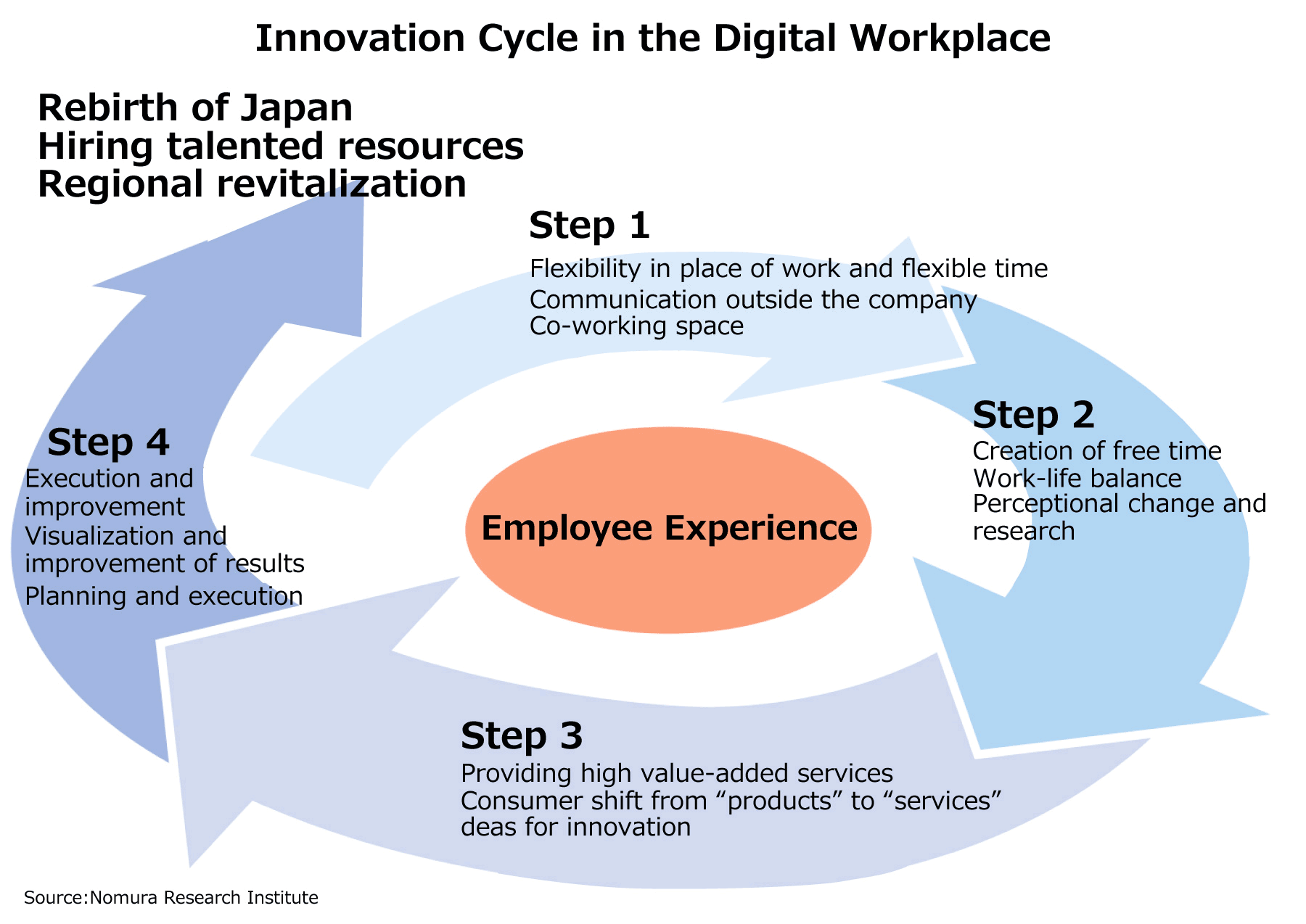
Future Working Style Ushered in by the Digital Workplace
"Digital Workplace (DWP)" aims to improve Employee Experience (EX) by combining the three elements of corporate culture, IT, and physical environment such as office space. In order to achieve this, Akira Kakinoki of Nomura Research Institute (NRI), who has been involved in the creation of a Digital Workplace, says that it is necessary to change workstyle values and continuously implement improvement cycles.
Towards an era where pyramidal structure will be obsolete
――Why is a new Digital Workplace necessary?
The first point is the phenomenon of low birth rate and aging society. Traditionally, organizations had a pyramidal structure, which is considered appropriate for the continuous mass production of good quality products. This pyramidal structure refers to a top-down organizational design, where many subordinates follow the instructions of the top management. However, due to changes in the population distribution such as population decline and aging society, traditional organizations are not on the frontline of growth strategies.
Since developing nations have become a hub of factories for the production of low-priced goods across the globe, developed countries are forced to bring innovation for differentiation. In addition, we have moved from an era of product deficit to an era of product surplus, and consumers’ values have also shifted from “products” to “services”.
In such a changing scenario, organizations seek a change where ideas can be summarized while discussing “the kinds of services that offer new experiences” rather than providing specific instructions from the top to the bottom. Therefore, a space where innovation can be created by collaborating and encouraging one another is more important than a pyramidal structure.
The first step is flexibility in place of work and flexible hours.
――What should we undertake to realize a Digital Workplace?
First of all, it is important to change the workstyle values. The style of working so far has been top-down management – resources are going through a long commute to reach the office situated in the city center at a specified time, sitting at the allocated seat, and doing exactly what has been instructed. However, to come up with one’s own ideas and create innovation, we need an environment where timings are flexible and resources can come in contact with a variety of experiences and collaborate with diverse people.
Thus, the first step is flexibility in place of work and flexible hours. For instance, the purpose of meetings can be achieved satisfactorily even if the participants are at distant places, by organizing a teleconference or sharing materials on a big display while interacting over the phone. The use of IT-supported environments allows resources to work at the free space within the office, to work from home or even in a co-working space where one can interact with people from other companies. If tele-working becomes possible, we will be able to work from anywhere, even from the rural areas as well as overseas.
―― Doesn’t it also lead to the “regional revitalization” being promoted by the government?
That’s right. The use of regional satellite offices will be noticeable before the spread of tele-working. It will open up opportunities to create new ideas while relaxing in regional offices. This will lead to “regional revitalization” promoting employment and industries taking root in rural areas.
Furthermore, reduction in travel time, reception of new incentives, and sharing of ideas can increase the opportunities for new ideas to be born. As a result, we ought to be able to break out of price competition with traditional competitors or with companies in developing countries, and shift to providing new values such as services that provide new experiences to customers.
As redevelopment is being carried out at various places lately, relocation of the head office is a big chance to introduce Digital Workplace. When the Yokohama and Tokyo offices of NRI were renovated two years ago, we promoted institutional reform by setting up the office environment and IT environment around the concept of “open air”. It is still in the process of trial and error, but only when we actually start using it will we be able to start noticing room for improvements.

Digital Workplace cannot be built in a day――Continue the improvement cycle
――Although the introduction of free working style may improve the Employee Experience (EX), it will make the management of working hours impossible.
For this, it is important to set appropriate KPIs (Key Performance Indicators) and check whether each of the initiatives are linked to the desired outcome. Then, if there are any problems, we should continue the improvement cycle. For instance, say we want to try tele-working, but the office is not yet fully paperless, and thus the required documents may not be available. Such problems are sure to arise. Digital Workplace is not something that can be finished all at once, rather it needs to be continuously improved.
――What do most companies find difficult when creating a Digital Workplace?
In most cases, they run into organizational barriers. That is, the responsibility for different things lies with different departments, such as the general affairs department for office space and fixtures, the information systems department for IT, and the HR department for setting up work formats and various systems at telework and satellite offices. Since each department takes decisions individually, it becomes difficult to maintain overall consistency, and time and effort is lost in adjustment. As a result, it is necessary to keep in mind the common goal of improving EX and overcome organizational barriers.
If companies can create some space during working hours, improve work-life balance, and improve employee satisfaction, they will be able to attract talented personnel and create and offer newer, more attractive services. For this purpose, we would like to support a number of companies from diverse perspectives such as IT, office environment, consulting, and so on.
Profile
-
Akira Kakinoki
* Organization names and job titles may differ from the current version.